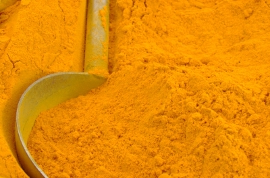Eat Your Medicine
By Herb Brody
The science behind turmeric and other so-called miracle foods

“How do certain foods help us be healthy and live longer? That’s what we’re trying to answer,” says Mohsen Meydani. Photo: John Soares
Turmeric, the stuff that gives curry its earthy flavor, has been credited with all manner of health benefits—from aiding digestion to relieving inflammation.
That made it a perfect candidate for study in the Vascular Biology Laboratory at Tufts’ Jean Mayer USDA Human Nutrition Research Center on Aging, which investigates the therapeutic properties of different foods.
“We know that certain things are good for your health—fruits and vegetables, nuts, and whole wheat,” says the lab’s director, Mohsen Meydani. “But why? How do certain foods help us be healthy and live longer? That’s what we’re trying to answer.” The lab focuses on the role of foods in two areas in particular: the formation of blood vessels and the development of cardiovascular disease.
The lowdown on turmeric is that its main bioactive component—curcumin—may indeed promote good health. In fact, Meydani has discovered some new properties. First, curcumin may help people lose weight. That’s based on studies of mice, in which a curcumin-rich diet appeared to have a significant slimming effect. And second, the substance appears to help keep arteries healthy.
The idea of testing curcumin for weight control was a matter of putting two and two together. Meydani knew that curcumin inhibits angiogenesis, the growth of blood vessels. In cancer research, the effect has been exploited to impede tumors.
He also knew that mice genetically engineered for obesity can avoid getting fat if they are injected when young with an anti-angiogenic drug, as has been shown in research at Harvard. “We figured we could make a connection here,” says Meydani. “We know that curcumin is anti-angiogenic. So let’s see what effect it has on weight gain.” After all, he says, fat cells, like tumors, need blood to grow.
A Steady Diet of Curcumin

The lowdown on turmeric is that its main bioactive component—curcumin—may indeed promote good health. Photo: iStock
He and his team gathered up some four-week-old lab mice and had them eat a veritable McDonald’s diet of fat-laden meals. Half the mice also consumed small amounts of curcumin—the human equivalent of a spoonful or two of turmeric daily. After 12 weeks, the curcumin-fed mice weighed, on average, some 10 percent less than the others.
While he knew that anti-angiogenesis played a part in slowing the growth of fat cells in the curcumin-fed mice, Meydani suspected there was more to the story. After all, the mice had been consuming a huge amount of calories. Were they simply excreting unused fat? On inspection, their droppings proved less fatty than the other mice’s, so there had to be some other explanation. Meydani concluded that the curcumin had amped up their metabolism: “The mice were burning the fat more quickly,” he says.
Should weight-conscious Americans start loading up on Indian spice? Not yet, says Meydani (though he confesses that turmeric is flavoring more and more dishes in the Meydani household).
For one thing, he has yet to demonstrate the weight-control effect of curcumin on older mice that are already overweight. He also hopes to try the substance on humans, and a proposal for such research is in the works, in collaboration with Susan Roberts, a professor at Tufts’ Friedman School of Nutrition and at the School of Medicine. But Roberts cautions that even this study will be preliminary.
Meanwhile, Meydani’s lab is investigating curcumin as a hedge against atherosclerosis, the inflammatory disease of arteries that restricts blood flow and can cause heart attacks.
Meydani believes curcumin may suppress the production of a protein that plays an important role in the disease, binding fatty acid molecules to vascular tissue. His experiments on cells cultured in a petri dish back him up. Now he wants to see if curcumin can prevent atherosclerosis in mice eating a high-fat diet.
Oats and a Cup of Green Tea
On the opposite end of the blandness spectrum, Meydani has good news about oats. The grain is already widely promoted for health—it is the only food for which the Food and Drug Administration allows the claim of a cholesterol-lowering effect.
Now the lab has discovered that a component of oats called avenanthramide, or AVEN, inhibits the proliferation of smooth muscles in the linings of blood vessels. Such proliferation is a factor in atherosclerosis. AVEN also enables cells to produce nitric oxide, which helps relax the smooth muscles, further lessening the chance of a heart attack.
If you’re thinking of joining the oatmeal-for-breakfast club, have your cereal with a cup of green tea, another target on Meydani’s nutritional research agenda. Like curcumin, green tea has anti-angiogenic properties, and—like curcumin—inhibits weight gain. Green tea can also slow the growth of tumors in some cancers, according to Meydani. “We’re working on what the molecular mechanism is.” he says.
Meydani sees his work as part of a trend toward scientific inquiry into the health benefits of substances that lie outside the usual definition of pharmaceuticals. He points out that the National Institutes of Health funds work through the National Center for Complementary and Alternative Medicine, which describes itself as promoting the study of “practices and products that are not generally considered part of conventional medicine.”
“It’s amazing,” Meydani says, “to see some of the answers for our problems are present in nature.”
This story first appeared in the Fall 2010 issue of Tufts Magazine.
